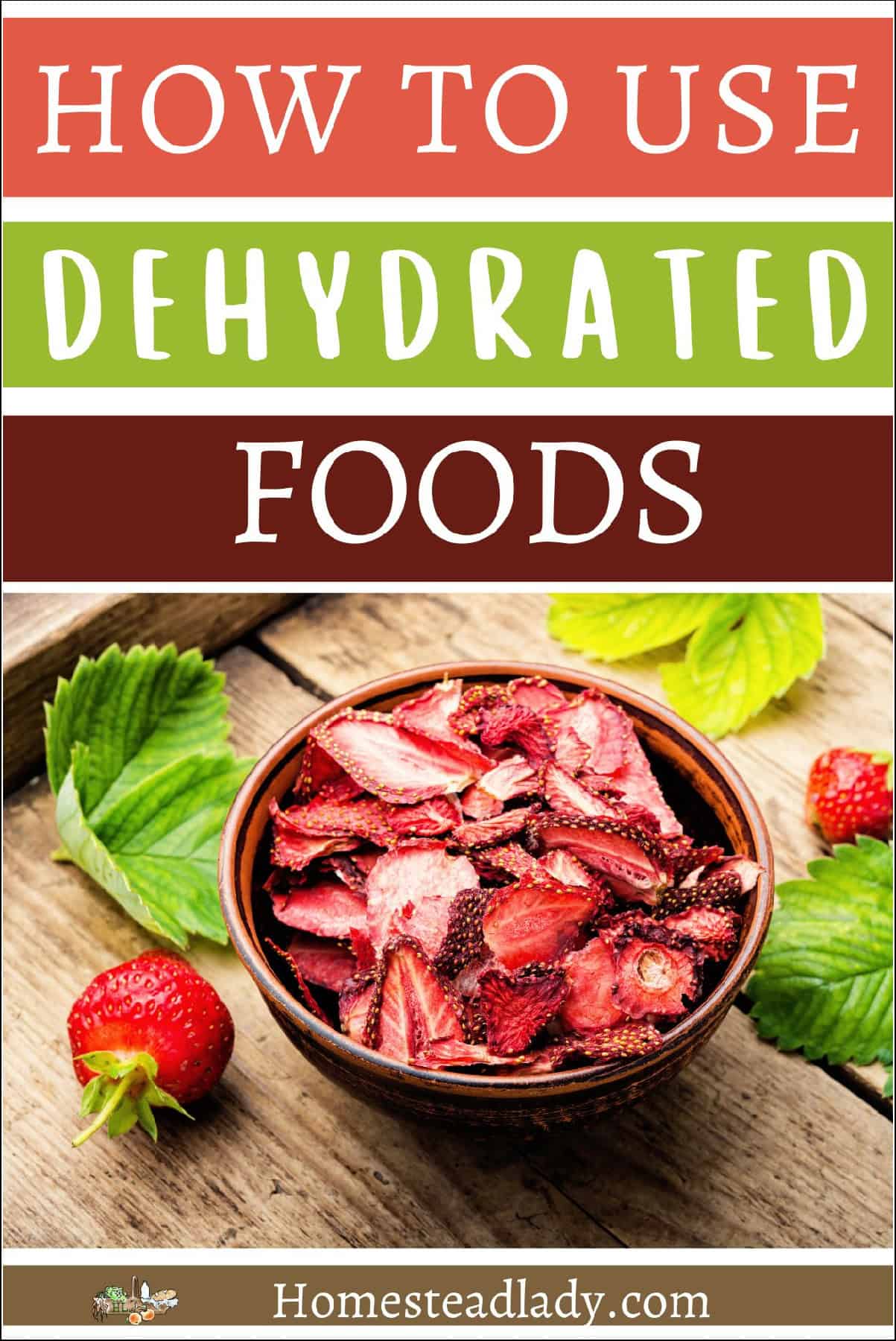Using Dehydrated Food: Fruits, Veggies, Herbs, More! • Homestead Lady


Using dehydrated food doesn’t have to be complicated! You’ve gone to all the trouble of learning how to dehydrate food, now it’s time to eat the results of your labor. Let us simplify learning how to use your dehydrated foods with lists of suggested recipes, as well as tips and troubleshooting. From veggies to fruit to herbs, we’ve shared our favorite ways of using dehydrated foods.
So, you’ve learned how to dehydrate foods of all kinds – fruit, veggies, herbs, and more! Have you figured out how to use them yet?
Using dehydrated food that you’ve preserved yourself is a challenge all on its own. Sometimes we set out our jars of beautifully dehydrated food only to stare at them wondering what to do with them!
Or maybe you’re still on the fence about dehydrating food at all and haven’t quite committed to the method.
Here are a few more resources for later reading:
If you’re new to preserving foods, learning to dehydrate food is a great place to start! Here are a few reasons to learn how:
All of the above applies to freeze dried food, too!
To help you keep your food preservation year organized and efficient, please join our email newsletter group to receive your FREE Food Preservation Worksheets. Print off only what you need and start filling in the worksheets! (There’s a black and white option for economical printing, FYI.)
Fruit is actually one of the most pleasing foods to preserve, and dehydrated or freeze dried fruit is particularly versatile and tasty.
For more information on the processes of dehydrating and freeze drying, please visit our article: Dehydrator vs. Freeze Dryer.
My favorite way of serving dehydrated fruit is simply as a healthy snack for the kids, but there’s a lot you can do with it.
You can also use the general instructions in our article Spiced Cranberry Punch or Kefir Soda. Swap out 1 cup of fresh cranberries for 1/4 cup of dehydrated.
Some dehydrated fruits are so versatile that you can use them for for both crafts and foods – like citrus!
While fruit is generally pleasing to eat (as in kids will eat it without complaint), large amounts of vegetables can be harder to integrate into meals.
Anywhere from 5-10 cups of veggies per day is a great goal for a healthy lifestyle, but that’s a lot!
Dehydrated vegetables are the friend of every parent trying to feed a picky kid because they easily integrate into any meal.
Since powdering is one of my favorite ways to use dehydrated vegetables, I’ve included a whole section on only that topic at the end of the post. There are several recipes linked in that section, but to get started, here’s how to powder dehydrated vegetables from Purposeful Pantry.
I highly recommend taking a lot of time to just hang out in her space.
Pop dehydrated veggies into the soup pot or Instant Pot. You can also add them to stew, or chili to rehydrate in the broth – no need to rehydrate first if you simmer long enough (20-45 minutes for most veggies).
Rehydrate and add to casserole, stir fry, strata, omelets, skillet dishes, and more. Purposeful Pantry can help you learn ways to rehydrate dehydrated food properly. See, I told you that Darcy’s site was just what you need to learn more!
You can also use the dehydrator to make vegetable chips, which are great for those looking for a grain-free snacking chip.
Here are a just a few veggies chips you can make:
Herbs are something that we usually air-dry simply because most of them will air-dry well. I only have so much space in my dehydrator (and my freeze dryer, for that matter), so if I can hang something upside down to dehydrate it, I will!
Some herbs, however, are too thick or too fibrous to air-dry in my humid climate. Some others simply have better texture when dehydrated.
For example, dehydrated cayenne peppers make fabulous salad and pizza topping. They also mix well into bread recipes, as well as any other recipe that is well-suited to dehydrated vegetables.
Working with dehydrated herbs in wellness recipes for tinctures, salves, and decoctions is much easier because they’re less likely to develop mold or mildew.
Ginger and turmeric are both fibrous rhizomes that need to be thinly sliced to dry evenly. They dry much better in a dehydrator, rather than by air in my climate.
Another favorite herbal food to dehydrate is mushrooms! Mushroom powder is much cheaper to make at home than to buy.
When they’re rehydrating, a lot of the flavor of the mushrooms goes into the water, making a kind of “stock”.
This means that you can save it for soups, as well as pasta and rice pots. This mushroom stock should be kept in the fridge and used within a week.
Learn to Preserve Mushrooms 3 Ways Here!
Vegetable and fruit powders are one of my favorite things about using dehydrated foods!
I absolutely hate canning tomatoes and tomato products like tomato paste and sauce. Instead, I dehydrate or freeze dry tomatoes, powder them, and then only add the amount of water I need for the recipe.
For example, to make tomato paste using tomato powder, use increments:
I suggest A Farm Girl in the Making’s article to learn more about making tomato paste, or better yet her book: A Farm Girl’s Guide to Preserving the Harvest.
I own this book and it’s fabulous for all kinds of food preservation methods! The truth is, I use a multitude of methods every year.
How to Make:
Take any vegetable powder and add 2 Tbsp. of it to this great homemade pasta recipe from Love and Lemons. Mix it into the flour before you add the egg.
Or to biscuits, like these simple sourdough discard pumpkin drop biscuits!
–>>Pin this Article for Later<<–
